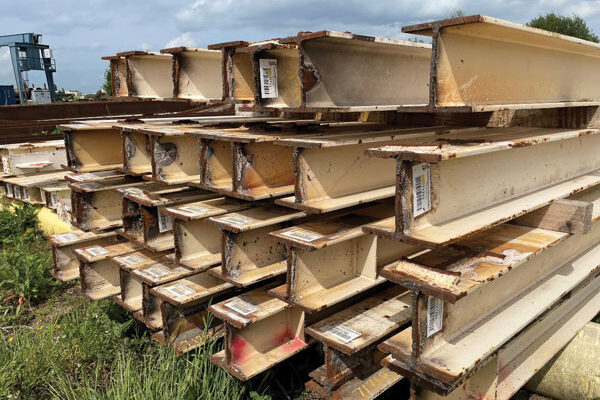50 & 20 Years Ago
50 Years Ago: Background to steel as a structural medium
Building with Steel, the BCSA’s ‘informative journal relating to the progress of and developments in the Constructional Steelwork Industry’ was first published in February 1960. Here’s how the magazine reported developments up to that point in its introductory article…
A LONG HISTORY
From the time the first large bridge was built in steel in 1890, when the Forth Bridge was completed using 51,000 tons of steel and 6½ million rivets, many famous bridges have been supplied from this country and erected in all parts of the world.
The first recorded example of a completely steel-framed building in Britain was a warehouse building constructed at Stockton-on-Tees in 1898, although a twenty-one storey building with a steel frame, then claimed to be the tallest in the world, was built in Chicago in 1892.
The Ritz Hotel is recorded as the earliest steel-framed building in London, being designed by the late S. Bylander and built from 1904. From that time onwards the use of steel-frame construction was a regular feature of all large buildings throughout the country and there were relatively few prominent structures built prior to the 1939/45 war which did not depend upon a steel framework for support. The behaviour of many of these buildings during wartime showed the merits of this form of construction.
STEEL SHORTAGES
Wartime conditions, however, also led to acute steel shortages, and it became necessary for the Government to urge ways and means whereby steel could be conserved for essential purposes of war.
Much thought and Government encouragement were given to developing alternative forms of frame construction and staffs which were versed in the design of steelwork gave place to those who were trained in the use of more readily procurable materials.
The wartime steel shortage continued to a greater or lesser degree until 1957 since when it has been possible to procure steelwork within a period regarded as reasonable in pre-war days. Not only has the supply position improved, but in the last eighteen months there have been significant reductions in the cost per ton of fabricated steelwork.
COSTS
Much has been said in recent years on the subject of comparative costs of alternative forms of framework for multi-storey buildings but it rarely happens that strict comparisons are possible.
Recent research and experience suggest that significant savings both in cost and time can be effected by the use of other than concrete fire encasement which is an important element of the cost of multi-storey construction. Hollow fire encasements in vermiculite or asbestos are being increasingly used and show advantages in many ways.
The recent introduction of universal beam sections, rolled in this country only since 1958, provides the means of saving weight and cost owing to the more efficient use of steel and the reduced amount of workmanship these sections normally entail.
The ready availability of high-tensile steel gives the designer great opportunities to reduce the weight of steel required for a given purpose, with the knowledge that all material has been rigorously tested throughout its manufacture, whilst the quality of the workmanship remains open for inspection.
CHOICE OF CONSTRUCTION
The use of high-tensile steel in no way affects the choice as to whether riveted or welded construction should be adopted. High tensile steel to B.S.968 can be welded as readily as mild steel, whilst the use of notch ductile steels in welded structures presents no difficulty in cases where the use of the somewhat more expensive type of steel is warranted.
There has been considerable progress in both the total tonnage and size of shop welded structural members, individual girders in excess of 100 tons in weight being by no means unusual. The use of welded girders to carry moving loads in structures such as crane gantries and railway bridges has for many years proved highly satisfactory both in appearance and in service.
The clean outline and plain surfaces of welded construction have attraction; perhaps it is in the field of portal construction where this is most apparent. Single-storey sheds in this form provide buildings in which almost all of the enclosed space can be used, and there are no roof trusses to encroach upon the space above the eaves level.
THE PLASTIC THEORY
Structural design has benefited greatly from the research of Prof. J. F. Baker of Cambridge University into the behaviour of structures and his development of the Plastic Theory. This method of design leads to lighter structures and the range of buildings to which it can be applied has been and will be greatly extended as the outcome of his great work.
THE FUTURE
The restriction of steel supplies in the post war period adversely affected its use for bridge work and led to an increased adoption of reinforced and pre-stressed concrete for the shorter spans. Adverse comments upon the heavy appearance of some of these structures and the more competitive position of steel construction from the point of view of both price and speed of erection should lead to a reaction in its favour.
During the past two years there has been a great revival of interest in bridge construction. Work is now proceeding on the great Forth bridge project, upon the Widnes-Runcorn and Tamar bridges, both of over 1,000 ft. span: also upon a number of viaducts incorporating medium span river crossings in connection with new motor roads, particularly in the north. All of these are of steel construction.
The industry remains active in work overseas, usually in the face of keen international competition. Major steel bridges have been constructed by British builders in India, Siam and Malaya, Ghana and Nigeria, Egypt and Iraq, Australia and New Zealand, Portugal and Iceland.
The development of motorways and modernisation of the railways will inevitably involve the construction of many new bridges and the replacement of existing ones. These developments offer great prospects for the structural steel industry.










